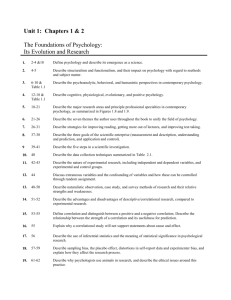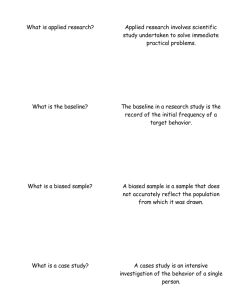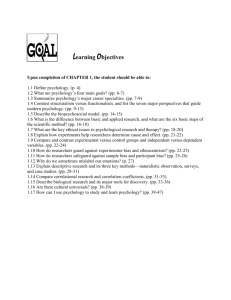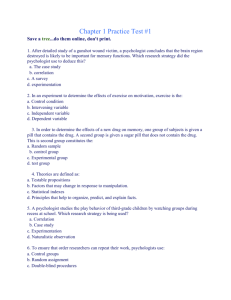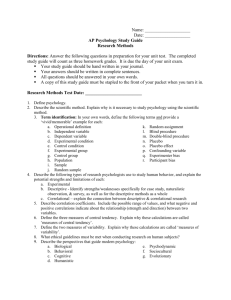Research Methods
advertisement
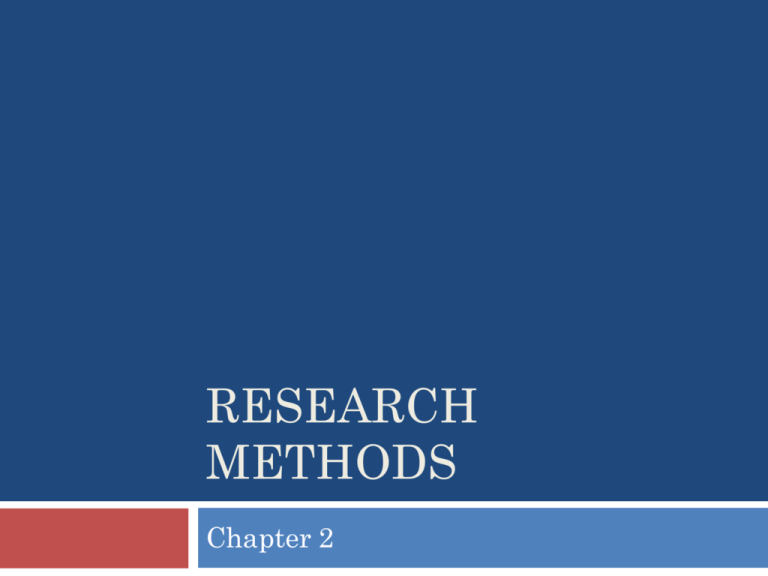
RESEARCH METHODS Chapter 2 Goals of Scientific Study Measurement and Description - develop measurement techniques that allow for the description of behavior Understanding and prediction – Hypothesis, Variables Hypothesis Variables Application and Control – Theory (From describing behavior to understanding behavior) Steps in Scientific Investigation Advantages to a Scientific Approach Two major advantages: Clarity and Precision Relative intolerance of errors Experimental Psychology Experiment-manipulates a variable under carefully controlled conditions and observes whether any changes occur in a second variable Cause and effect independent variable – manipulating dependent variable – measuring experimental group - receive manipulation/treatment Control group - do not receive manipulation/treatment extraneous variables - likely to influence the dv(other than iv) Experimental Psychology Con’t. CONFOUNDING OF VARIABLES – TWO VARIABLES LINKED TOGETHER ADVANTAGES OF EXPERIMENTS: CAUSE AND EFFECT RELATIONSHIPS AVAILABILITY OF CONTROL DISADVANTAGES OF EXPERIMENTS: ARTIFICIAL •The artificiality of the lab setting may influence subjects’ behavior Experimental Psychology Con’t. UNEXPECTED AND EXTRANEOUS VARIABLES MAY CONFOUND RESULTS NOT ABLE TO GENERALIZE CAN’T EXPLORE SOME RESEARCH QUESTIONS Research Methods in Psychology Correlational Research Research technique based on the naturally occurring relationship between two or more variables Often used to make predictions, such as the relation between SAT scores and school success Cannot be used to determine cause and effect Research Methods in Psychology Naturalistic Observation Systematic observation in natural setting The main drawback is observer bias The presence of an observer may alter the participants’ behavior Research Methods in Psychology Case Studies Detailed description and analysis of one or a few people Prominent in psychology Observer bias is a problem Unable to make generalizations past person being studied Research Methods in Psychology Surveys Questionnaires or interviews, such as polls prior to an election Can generate a lot of information for a fairly low cost Questions must be constructed carefully so as to not elicit socially appropriate answers Sampling biases can skew results Accuracy depends on ability and willingness of participants to answer questions accurately Statistics and Research Descriptive statistics – organize and summarize data Central Tendency – typical or average score Mean-average – sensitive to extreme scores Median-middle of distribution Mode-most frequent score Statistics and Research Variability – scores vary from each other standard deviation – index of the amount of variation The lower the variation, the closer the scores are to each other How to get the SD (Example) Your numbers: 3, 17, 5, 19, 7, 6, 5 Find the mean: (3+17+5+19+7+6+5)/7 = 8.857 Find your deviations: 3-8.857 = -5.857; 17-8.857 = 8.143; 5-8.857 = -3.857; 19-8.857 = 10.143; 7-8.857 = -1.857; 6-8.857 = -2.857; 5-8.857 = -3.857 Square your deviations: 34.304, 66.308, 14.876, 102.88, 3.448, 8.162, 14.876 How to get the SD cont. Add them up: 34.304+66.308+14.876+102.88+3.448+8.162+ 14.876 = 244.854 Divide by one less the total number of items: 2.44.854/6 = 40.809 Find the Square √40.809 ≈ 6.39 An example for the ages Data In this class, there are 20 students that range from 15 to 18. Math 15 = 3; 16 = 4; 17 = 8; 18 = 5 Mean Age: 16.75 Median: 17 Mode 17 (15-16.75)2 x 3 = 9.189 (16-16.75)2 x 4 = 2.252 (17-16.75)2 x 8 = .504 (18-16.75)2 x 5 = 7.815 Sum equals = 19.76 Divided by one less than total students = 1.04 Finding the square root = 1.02 Curve looks like this!!! Statistics and Research Correlation – association between 2 variables correlational coefficient – numerical index of relationship between two variables Positive and Negative correlation • Closer the correlation to either -1.00 or +1.00 the stronger the relationship. Coefficient near zero indicates no correlation. Statistics and Research Correlation Positive Correlation –Two factors that follow the same direction I.e., - High SAT scores predict High school success I.e., - Low SAT scores predict Low school success Negative Correlation. – Two factors that do not follow the same direction I.e., - High SAT scores predicts Low school success I.e., - Low SAT scores predicts High school success Inferential Statistics Inferential statistics - interpret data and draw conclusions Statistically significant – research results are unlikely to be due to chance Flaws In Evaluating Research Replication – repetition to see if earlier results are duplicated Sampling Bias – sample is not representative of the population Sample-subjects selected population-from where the sample is drawn Placebo effects – participants expectations lead them to experience some change; ineffectual treatment Self-Report data: Social desirability bias – socially approved answers response set – response to questions in a particular way/unrelated to content of question Flaws In Evaluating Research Con’t. Experimenter Bias – researchers expectations influence the results obtained Double-blind procedure – neither subject or experimenter know experimental or control group Ethics & Guidelines Humanitarian II. Informed Consent III. Justification Deception = see debriefing IV. Right to Withdraw V. Risks and Benefits VI. Debriefing VII. Confidentiality I.


